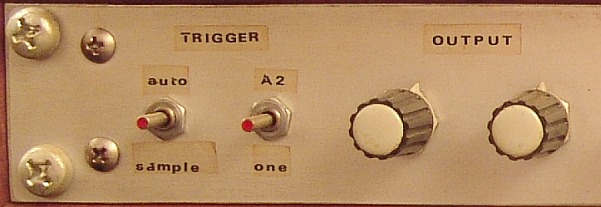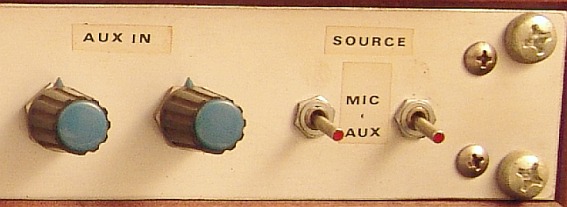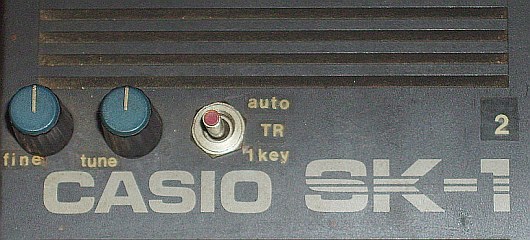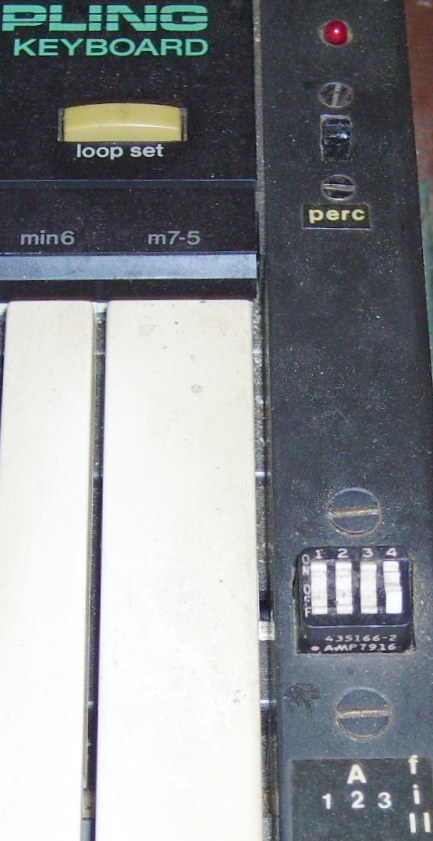The Twin layout

|
The lower Casio, KB 1, doesn't have its printed circuit board inside any more. It is moved to the wooden 19 inch case in the middle. Under the case is the power unit. A switch is added on KB 1 to disable the internal speaker, and the volume slider is removed. A button 'D' is added, to get an existing preset-sound, which is not used in the matrix. (KC5-KI4) Since all control from keys and buttons is done with a scanned diode matrix, KB 1 is connected with a flat cable with D-connector, having all x-y lines, power, etc., to the pcb in the case. This matrix gives the opportunity to easily 'break in' on any control with a bridging diode contact. |
Section A

|
KB 1 has now two trigger inputs, via transistor-driven optocouplers, with the choice of : 1a - auto(play), to start playing back the recorded sequence of real-time notes 1b - sample, e.g. if an external instrument produces both a start-pulse and a following sound 2a - A2, the middle A-key on the keyboard. The key that plays a sample with its original frequency 2b - one, triggering the 'one key play', which plays back the saved sequence-notes step-by-step This 'one key play' is a nice feature, because it gives a different use of the same existing sequence. While 'autoplay' produces a replica of what notes has been recorded including the pauses in-between, 'one' plays only the recorded notes step-by-step, skipping the time-data of the pauses. This is nice for synchronization with other sequencers and their (derived) clock pulses. Since all in- and output audio lines of KB 1 and KB 2 come together in the middle case, buffer opamps are added with pots for both final output volumes. |
Section B

|
The two 'sample' pots are volume settings for the 'ping-pong' section. In this way, the output of KB 1 can be sampled by KB 2 and vice versa. This can be enabled by the switch to the low right with the pingpongbat. If this switch is on 'aux', the keyboards do sample from an outside source. This option provides a technique, where the 1st KB plays a chord (max 4 keys), sampled by the 2nd, which then has the whole chord produced under one key. The same goes for a sequence of notes. The 'Fill' switch is provided, caused to the fact, that the SK-1 has a built-in circuit to switch off power after some minutes, if nothing is touched. This had the negative outcome, that I could loose a recorded sequence in memory, while I was busy preparing or playing another instrument in the meantime. Which was quite annoying in some cases. Couldn't manage to disable the so-called APO-circuitry directly, so I searched for a trick. Since the power didn't shut off as long as some button was pressed, I found the 'fill' button, because normally it doesn't do anything, as long as not the silly preset rhythm-percussion is selected. The red led in the middle is the sampling-indicator. The 'perc' switch under the led switches off any percussion sounds. It appeared that these sounds had a seperate audio-line in the circuitry towards the output mixer. This shouldn't have been that bad, as long as one doesn't use those silly rhytms, but the same line gives a loud 'ping' after the machine has finished sampling something, as an indicator. This can be very inconvenient, if one is performing on a stage with 2000 Watts amplifiers. I had to physically carve an interruption on the pcb for this. The 'A1' switches permanently on the lowest 'A' on KB 1. The 'oct' switch is a choice for lower or higher octave range of KB 1, by VC trimmed inside. 'Tune' and 'Fine' pots are for the range and fine-tuning control of the clock-frequency. |
Section C

|
Input sources for both KB's. Since the only difference between the mic and line input of the SK-1 appeared to be an extra serial resistor in the input-line, I chose for connection with the line-input, so adding two opamp-circuits for a pre-amplification of microphones. |
KB 2
This is the one on top of the twin-case, still with its own pcb inside, less modifications.
Nothing was removed, except the clock. The rest added within the available space of the SK-1 case.

|
Two pots are added for setting the clockspeed, one for fine-tuning and one for the raw range. Due to its own added VCO circuit. KB 2 has one trigger input, leading to an added switch to activate 'autoplay' or 'one key'. |
|
On the right : A LED to indicate sampling or setting-to-loop actions going on. As an alternative while blocking the percussion line with the added switch, to avoid the loud ping during such actions. |

|
Added at lower right. Block of 4 dipswitches on a tiny pcb connected to the matrixlines. The first 3 can lock key 'A' of the 3 available octaves. Nr 4 sets the fill-button, to prevent the APO-timer from switching off power while something else. |
The default presets

|
Portamento can be treated in different ways. This effect acts only, if some key is still down, and a new one is pressed. This means, that one can control the effect to be active or not, while playing. Is a key is released, before the next one is touched, no portamento. If still down, there is. At the bottom types of envelopes to select are shown, chosen with a key. Diff. attacks and decays. Memory : don't touch 'demo.'. It's horrible and just a waste of ROM-space. 'Clear' wipes the memory, 'Reset' goes to start, 'Delete' can wipe a single note in the sequence. 'One key play' is a very odd design. It has two buttons, but both do exactly the same thing. . . |